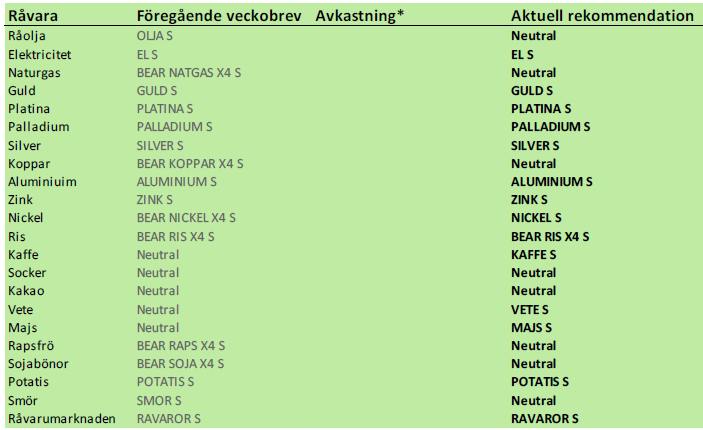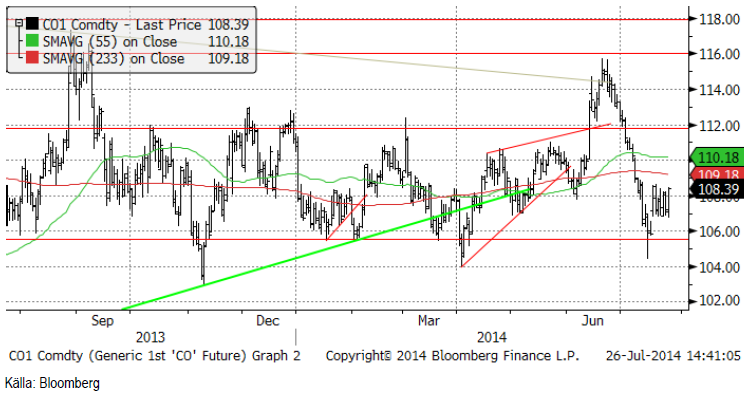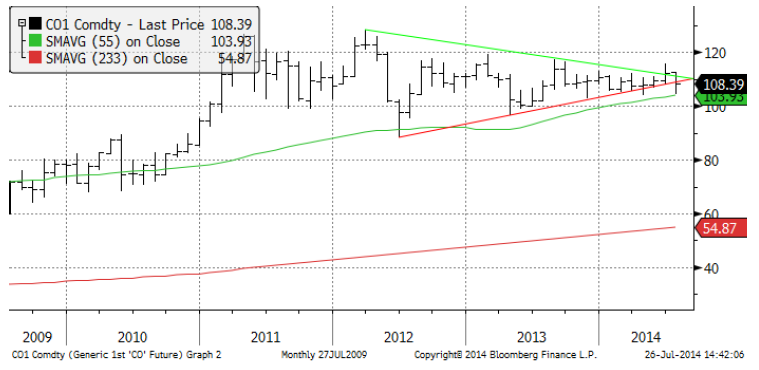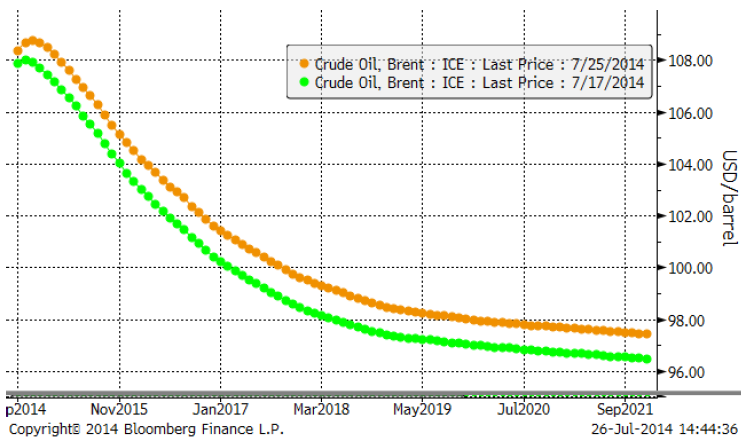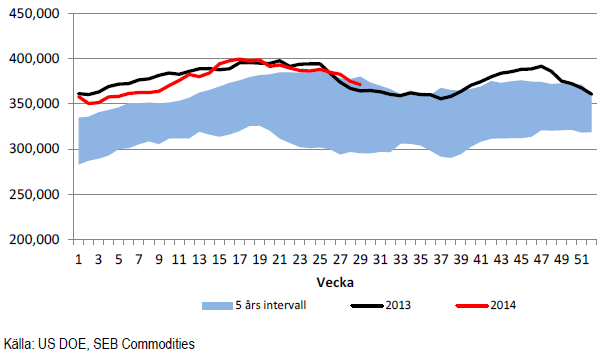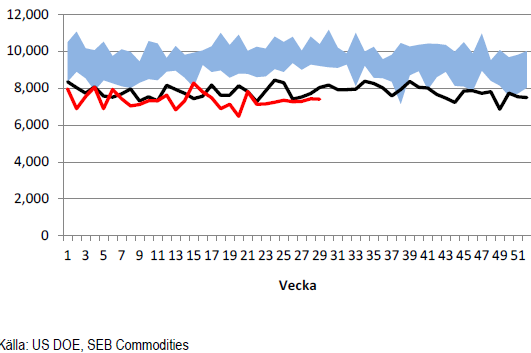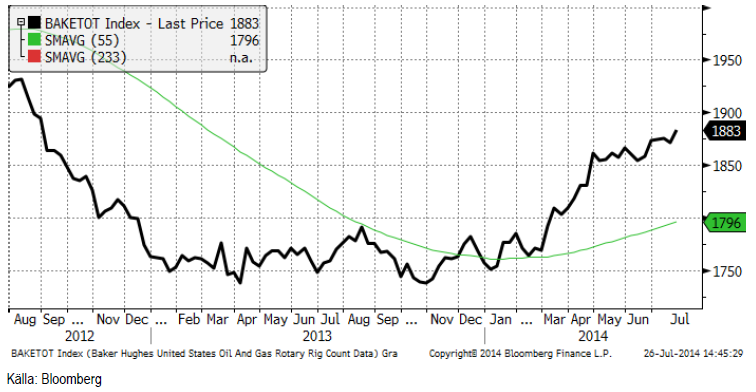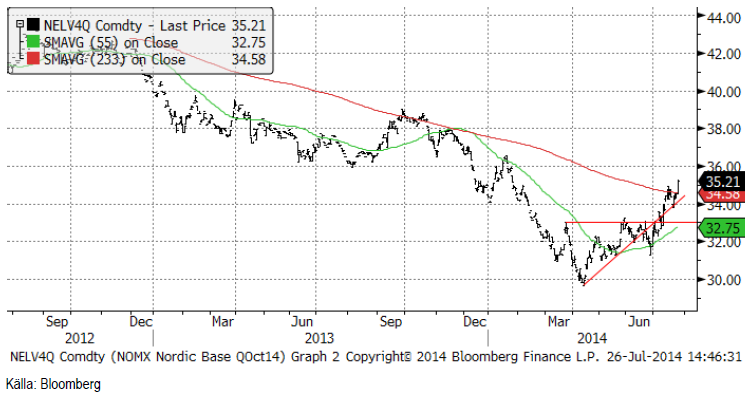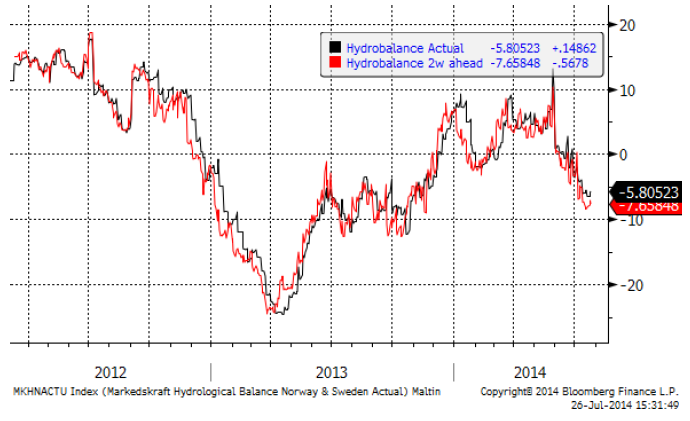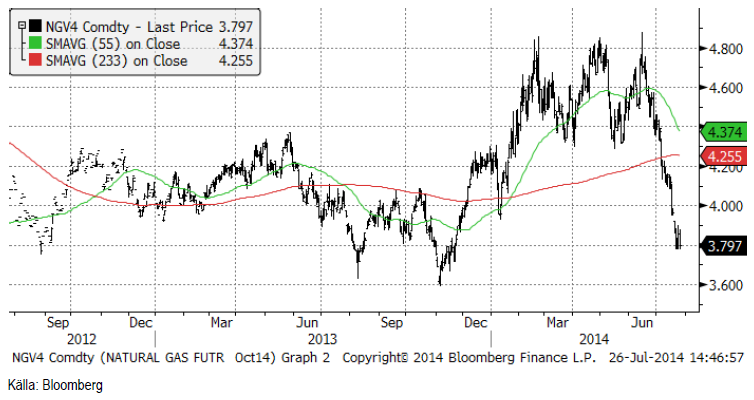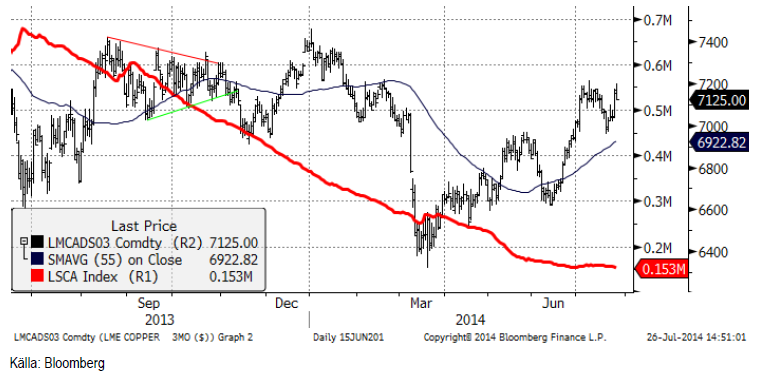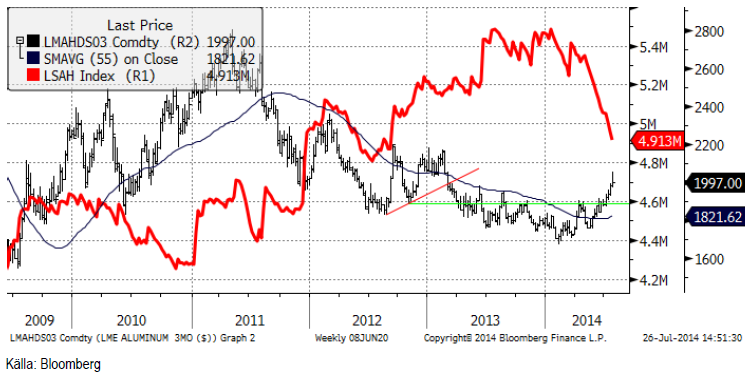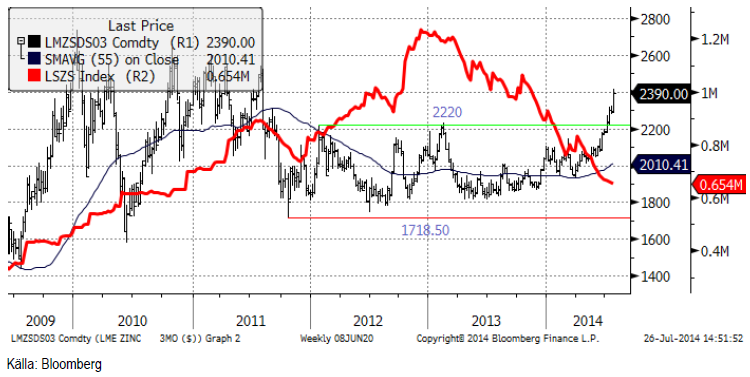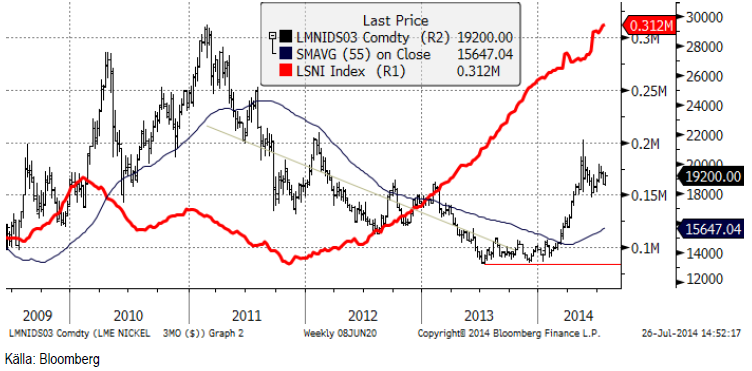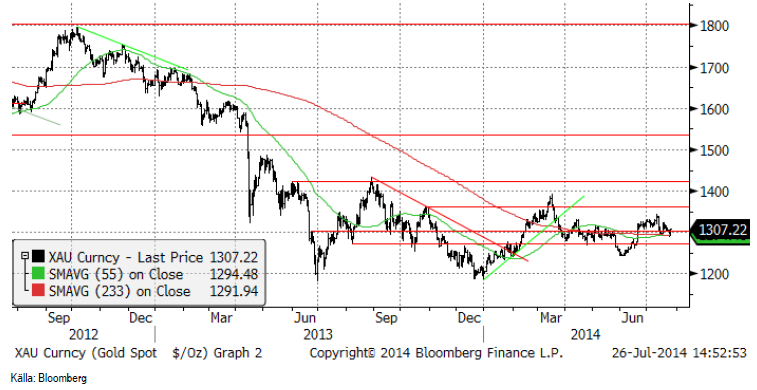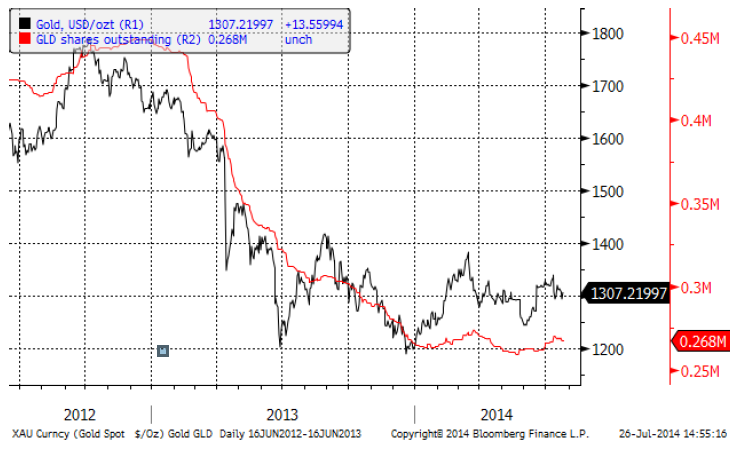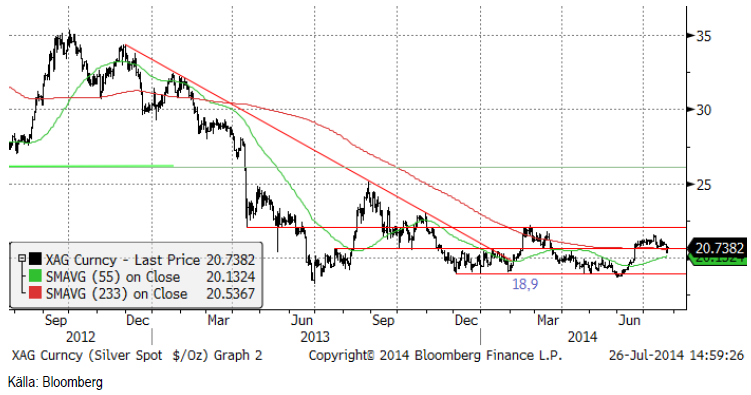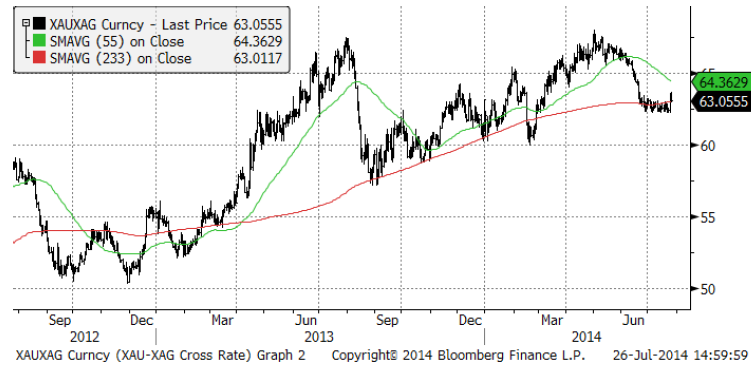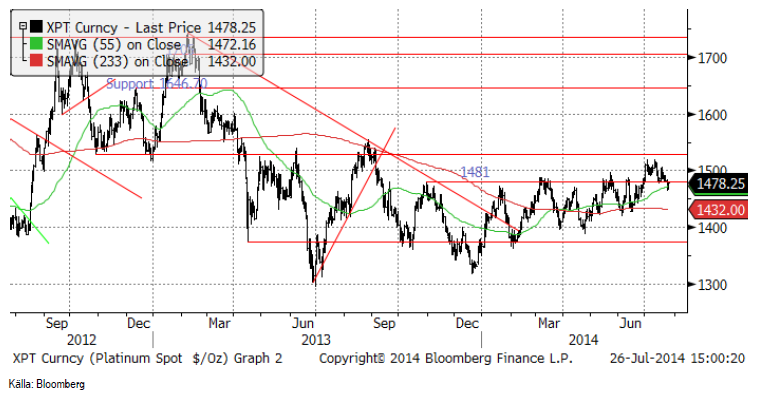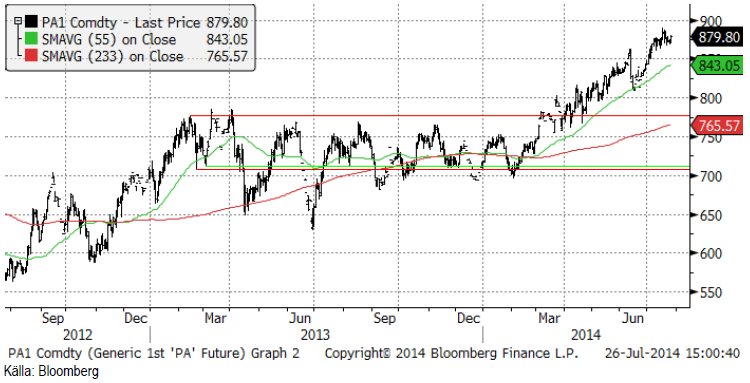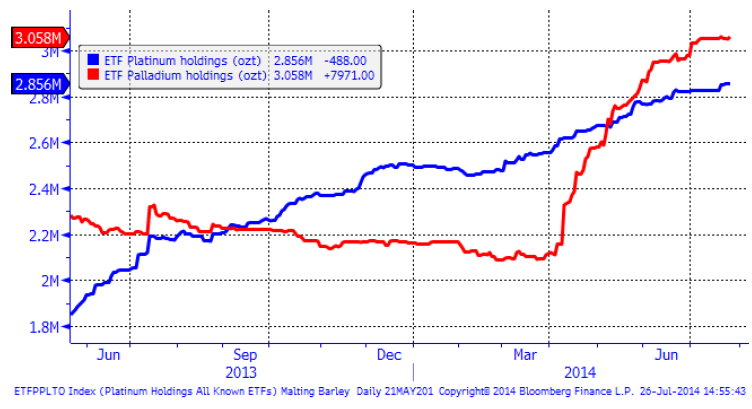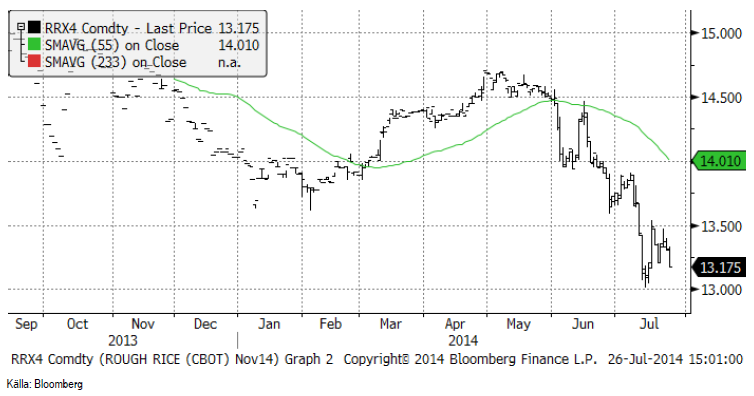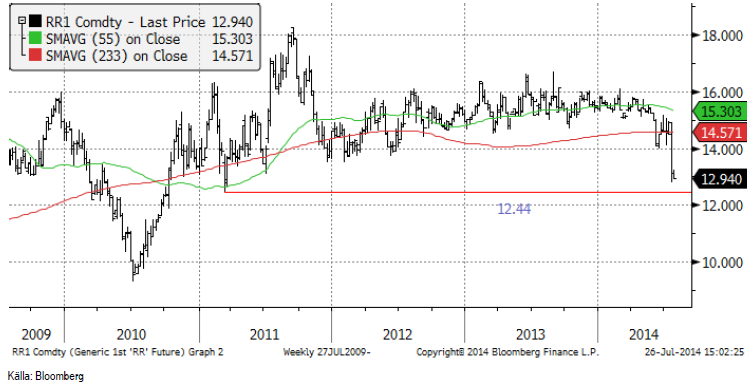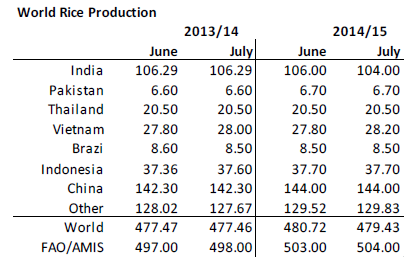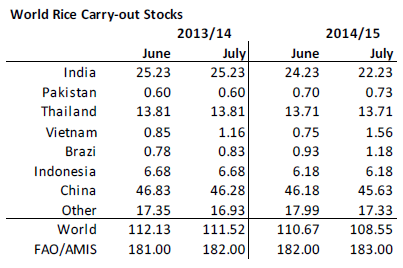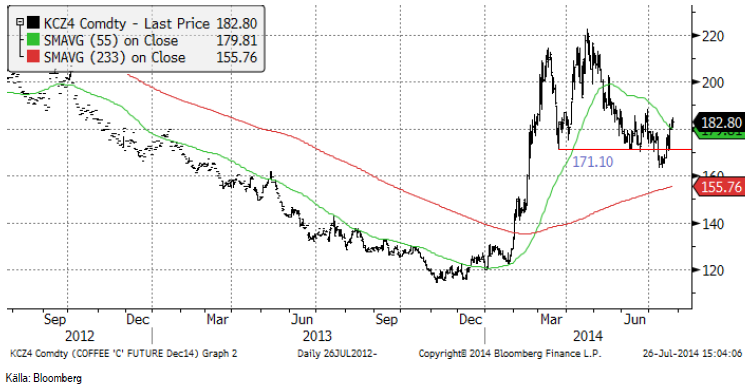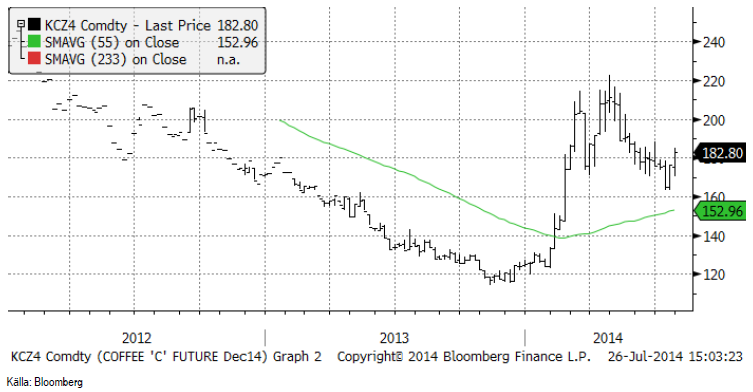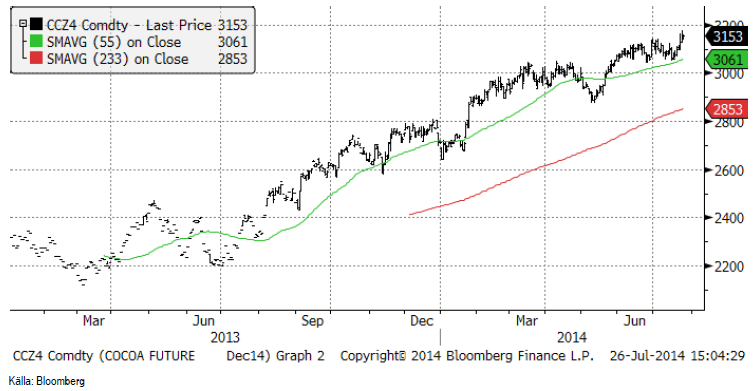Analys
SEB – Råvarukommentarer, 28 juli 2014

Rekommendationer
*) Senaste veckobrevet kom den 9 juni.
Kort sammanfattning
Efter sommarens prisrörelser, där vete, majs, soja och raps fallit kraftigt i pris, anser vi att det mesta av de exceptionellt positiva faktorerna för årets skörd är diskonterade i priset. Vi går därför över till köprekommendation på vete och majs och går från sälj till neutral på oljeväxterna.
Priset på mjölkterminerna har fortsatt ner och prisfallet i dem får nu med vanlig eftersläpning genomslag i avräkningspriserna hos mejerierna.
Det myckna regnandet under sommaren i Tyskland och Frankrike har gjort att potatispriset har fortsatt att falla. De ligger nu på hälften av den prisnivå de gjorde i våras.
Elpriset trendar uppåt och vi tror att trenden håller i sig.
Under sommaren har basmetallerna börjat röra sig uppåt, med förvånande stora prisuppgångar i koppar, aluminium och zink.
Råolja – Brent
De senaste dagarnas handel, i princip efter nedskjutningen av passagerarflygplanet över Ukraina, har oljemarknaden varit mer volatil än vanligt och pendlat mellan 107 och 108.50 dollar praktiskt taget varje dag.
I juni bröt oljepriset den stora triangelformationen på uppsidan, vilket var en köpsignal. Därefter vände priset ner kraftigt och ligger nu under triangelformationen. Det är alltså en teknisk säljsignal.
Terminerna på brentolja har gått in i contango för de närmaste månaderna. För längre löptider råder dock fortfarande backwardation. Det kan vara värt att notera att marknaden handlat upp de riktigt långa terminer till 98 dollar för år 2020.
Råoljelagren i USA fortsätter att minska enligt normalt säsongsmönster. Lagren är dock högre än förra året.
Importvolymerna till USA har varit stabila och ligger under förra årets.
Nedan ser vi ett diagram på antalet oljeriggar i USA, som fortsatt att stiga enligt Baker Hughes statistik.
Mexikanska Pemex förutspår en ytterligare nedgång i landets oljeproduktion till 2.41 mbpd, den lägsta nivån sedan åtminstone 1990. Samtidigt fattas belsut i veckan som kommer som slutgiltigt gör det möjligt för privata företag att utvinna olja i Mexiko för första gången sedan 1938. Planen är att stora investeringar ska göras för att till 2020 öka produktionen. Mexiko har dels haft oljeproduktionen i ett statligt monopol och dels haft en produktionsskatt på 99.5% av försäljningspriset på olja. Inte mycket har blivit kvar i bolaget för underhåll, än mindre för nyinvesteringar.
Det är fortfarande oroligt vad gäller Iraks produktion. Iran förefaller att samarbeta med IAEA. Rysslandskrisen ser ut att kunna bli värre. Ryssland är dock helt beroende av intäkter från olje- och gasproduktion och problem på andra områden, leder till ett intresse att sälja ännu mer av dessa varor. Intuitivt kan man tro att en eskalerad konflikt kan leda till högre pris på råolja, men det är inte alls säkert, eller troligt.
Med det contango som nu råder, får man betalt för att ligga kort. Vi tror inte på en köpt position, men nöjer oss för närvarande med att inte ha någon position alls.
Elektricitet
Trenden i elpriset är uppåtriktad och vi tror att det finns ytterligare potential uppåt. Vid 36 euro finns dock ett relativt kraftigt tekniskt motstånd. Risk / reward gör att vi rekommenderar neutral position.
Värmen i Sverige har medfört att Oskarshamn 3 sänkt effekten eftersom kylvattnet är för varmt. Det är såvitt vi vet första gången detta hänt i Sverige. I Tyskland och Frankrike med sina kraftverk längs floderna händer det då och då.
Hydrologisk balans har de senaste månaderna sjunkit till ett underskott.
Vi går över till neutral position.
Naturgas
Det sista jag skrev i juni var att ”Vid 4.80 finns dock tekniskt motstånd och sannolikt är det en bra nivå att sälja på.” när jag rekommenderade köp av BEAR NATGAS X4 S. Efter det stora prisras som inträffade efter uppgången till 4.80, ner till 3.98 i fredags, är det dags att stänga den positionen och ta hem vinsten. Nivån 3.80 är en teknisk stödnivå, där priset vänt uppåt flera gånger tidigare, som vi ser i diagrammet nedan.
Gaslagren i USA ökade den senaste veckan med 90 miljarder kubikfot. Det normala för den veckan är en ökning med 46 miljarder enligt IEA. Det var den 14:e veckan i rad som lagren har ökat mer än normalt. Produktionen av naturgas i USA väntas av EIA öka med 4.1% i år, vilket gör att lagren i USA når rekordnivåer inför vintern.
Koppar
Kopparpriset har stigit med 5% sedan den första juni. Det har varit mindre effekt än väntat av inleveranserna av metall till LME:s lager från lagerhusen i Qingdao, i kölvattnet efter den dubbelpantsättningsskandal som rullades upp i början av sommaren.
Efterfrågesituationen utanför Kina har förbättrats något. Importen till Kina är dock fortfarande svag. Den allmänna uppfattningen att ny produktion kommer att komma igång verkar dämpande på prisutvecklingen.
Vi rekommenderar neutral position i koppar.
Aluminium
Aluminiumpriset har stigit med 11% sedan den första juni. Generellt sett kan man säga att investerarintresset gått från nickel till aluminium och zink. Aluminium ansågs i början av sommaren vara relativt prisvärt, medan nickel ansågs ha diskonterat lite mer än sitt värde.
Lagren av aluminium på LME har sjunkit med 10% sedan i april. Mycket tyder på att detta till stor del beror på att tackor flyttats från LME:s lagerhus, som är relativt dyra, till billigare lagerhus utanför LME. Konsumtionen tycks emellertid vara stark och det råder en viss brist på metall utanför Kina. Konsumenterna är dock inte aktiva på LME, utan det är framförallt hedgefonder som är aktiva på köpsidan. Det förekommer viss hedging från producenter och marknaden väntar sig mer av detta om priset fortsätter att stiga.
Kortsiktigt är marknaden överköpt, då priset på kort tid stigit till den övre delen av trendkanalen. Vi kan vänta oss en rekyl nedåt de kommande veckorna. Tekniskt stöd finns på 2000 dollar / ton och det är en viktig nivå från ett tekniskt perspektiv.
Vi fortsätter alltså med köprekommendation på ALUMINIUM S.
Zink
Zinkpriset har stigit med 17% sedan den första juni. Den gradvisa förbättringen i den fundamentala balansen (som visas av ILZSG) återspeglas äntligen i ett högre pris. LME-lagren sjunker stadigt.
Zink var delvis omfattad av Qingdao-skandalen (dubbelpantsättning av metall i kinesiska lagerhus), vilket fortfarande utgör en risk (liksom för koppar), att okänd mängd material kommer att dumpas in på LME. Detta har dock inte hänt (än).
Prisuppgången som accelererat den senaste tiden, känns dock lite överdriven.
Nickel
Nickelmarknaden har konsoliderat sig efter haussen under januari till maj. Ett produktionsunderskott väntas prägla marknaden givet att Indonesiens exportförbud av obearbetad malm håller i sig. Lagren är fortfarande höga, men borde givet underskottet börja minska.
Den tekniska bilden av prisutvecklingen antyder att ett brott uppåt kan komma snart. Den fundamentala förbättringen av läget kan komma först under årets sista kvartal.
Produktionen av rostfritt stål, som 70% av all nickel används till, utvecklar sig starkt. Produktionen ökade med 10% under årets första sex månader. Det tredje kvartalet har inte varit så svagt som förväntat.
Frågan är om nickelpriset kommer att tjuvstarta med en uppgång innan fundamenta förbättrar sig, ännu en gång?
Vi rekommenderar en försiktigt lång position, där risk/reward förbättras om man lyckas köpa på rekyler nedåt.
Guld
Guldmarknaden ser piggare ut. Det senaste året har priset på guld befunnit sig i konsolidering. Den stora frågan är om det kommer att komma en ytterligare prisnedgång när konsolideringsfasen är över, eller om den utgör en bas för en ny uppgångsfas. Vi lutar åt att det handlar om en konsolidering inför en uppgång i priset.
Nedan ser vi antalet andelar i GLD-fonden och guldprisets utveckling. Vi ser att flykten från guldfonden GLD upphörde vid årsskiftet. Hittills i år har antalet andelar bara fluktuerat lite upp och ner.
Vi rekommenderar köp av GULD S.
Silver
Silverpriset befinner sig ännu tydligare i konsolidering inom ett snävt prisintervall.
Nedan ser vi ett diagram över priset på guld uttryckt i silver. Silver, som är billigt i förhållande till guld, har vunnit mark i förhållande till guldet. Vi tycker dock fortfarande att silver är mer köpvärt än guld.
Vi anser att silver är mer köpvärt än guld och skulle vilja köpa på de här nivåerna. Vi rekommenderar köp av SILVER S.
Platina & Palladium
Platinapriset orkade inte över motståndsnivån vid 1525 dollar per ozt och har i juli fallit tillbaka till 1478. Marknaden behöver bryta igenom 1525 dollar för att vi ska kunna säga att konsolideringsfasen är över och vi har en uppåtgående marknad. Det finns nu en risk för att marknaden vänder ner, men än så länge håller vi fast vid köprekommendationen.
Prisdiagrammet på palladium ser vi nedan. Priset närmar sig 900 dollar. Vi anser att rekyler ska ses som tillfällen att köpa på och fortsätter med köprekommendation.
Nedanför ser vi hur mycket metall som finns i börshandlade fonder för platina respektive palladium.
Vi rekommenderar köp av PLATINA S och PALLADIUM S.
Ris
Priset på ris (novemberkontraktet på CME) har fortsatt falla den senaste månaden. Vi tror att prisfallet fortsätter, då risken för ett El Niño, som skulle kunna orsaka torka i Sydostasien, har minskat ytterligare.
Nedan ser vi ett vecko-chart över prisutvecklingen de senaste fem åren. Vi ser att det finns ett starkt stöd vid 12.44 dollar per cwt och det gör att nedgångsfasen snart kan vara över.
Den 3 juli presenterade FAO/AMIS sina uppdaterade estimat och den 11 juli kom USDA. FAO/AMIS justerar upp estimatet för global risproduktion med 1 mt till 504 mt, hänförligt till högre väntad produktion i Burma, Pakistan och Tanzania. USDA justerar dock ner sitt produktionsestimat med nästan 1.5 mt på global basis med en sänkning på 2 mt i Indien, vilket kompenseras delvis av en liten höjning för produktionen i Vietnam. Det är rimligt att vänta sig en lägre skörd i Indien eftersom monsunen hittills varit 30% lägre än normalt. Ser vi framåt, kan vi dock konstatera att monsunen nu är normal.
Pga lägre produktion erhåller USDA ett estimat för utgående lager som är lägre. Konsumtionen påverkas inte mycket av de väderfaktorer som påverkat produktionen. Inte heller FAO/AMIS har förändrat sitt estimat på konsumtionen 2014/15 utan behåller den på 502 mt. FAO:s estimat på 1 mt högre produktion leder därför till 1 mt högre utgående lager i deras rapport.
Vi fortsätter att rekommendera köp av BEAR RIS X4 S.
Kaffe
Vi följer utvecklingen i decemberkontraktet för arabica i New York, KCZ4. Vi gick över till neutral rekommendation i början av juni, men går nu över till köprekommendation.
Enligt Volcafe, kommer världsmarknaden för kaffe (arabica + robusta) att ha ett produktionsunderskott på 11.3 miljoner säckar (60 Kg) under 12-månadersperioden som börjar i oktober. Perioden oktober 2013 till sista september 2014 har ett överskott på 4.7 miljoner säckar, enligt Volcafés estimat.
Den senaste tidens prisuppgång beror på att det regnar 6 gånger mer än normalt i Brasiliens delstat Minas Gerais, den viktigaste kaffeproducenten i landet. Det är vinter i Brasilien nu och vanligtvis regnar det nästan inte alls där nu. Regnen fördröjer skörden, som normalt sett skulle ha varit som mest intensiv just nu. Det finns rapporter om bladrost och kaffeodlarnas organisation har flaggat för att produktionen nästa år kan bli 40 miljoner säckar, vilket skulle bli den minsta skörden sedan 2009.
Den senaste månadens prisuppgång ser ännu mer signifikant ut i nedanstående månadschart på prisutvecklingen i decemberkontraktet på arabica. Det ser ut som om det skulle kunna hända mer på uppsidan.
Vietnam går mot ett nytt rekord i produktionen av robusta under säsongen oktober 2014 till oktober 2015. Skörden inleds i oktober, eftersom landet befinner sig på norra halvklotet. Produktionen kan enligt en sammanställning av analytikers estimat på Bloomberg nå 1.87 miljoner ton (31.2 miljoner säckar). Detta är 8.7% mer än rekordet 2013/14. Anledningen till detta är att odlare bytt till modernare sorter. Den genomsnittliga avkastningen per hektar kan komma att öka från 2.65 ton till 2.83 ton (+6.8%). Arealen ökar samtidigt från 650,000 ha till 660,000 ha enligt sammanställningen. De senaste tio åren har produktionen i Vietnam ökat med 100%. Produktionen i Indonesien har däremot ”bara” ökat med 30%, vilket i princip motsvarar ökningen i Indonesiens inhemska konsumtion. De kommande två åren kan Indonesiens konsumtion öka med 30%.
Med nya sorter kan avkastningen per hektar i Vietnam nå 6-7 ton, medan gamla sorter kan ge så lite som 1.5 ton. Vissa odlare har en avkastning på 8-9 ton per hektar med nya sorter. Även om arealen inte skulle öka, finns alltså potential för Vietnam att öka produktionen flera gånger om. Två andra grödor konkurrerar om odlingsmarken med kaffe: peppar, där Vietnam är värdens största producent och gummi, där Vietnam är världens tredje största producent.
Pga problemen med skörden och med utsikterna för nästa års skörd i Brasilien, väljer vi att gå över till köprekommendation.
Kakao
Decemberkontraktet på kakao i New York, CCZ4, nådde treårshögsta notering i veckan, samtidigt som terminskontrakten i London nådde ”2000 pund”. Skyfall i Västafrika oroar marknaden för skador på odlingarna. Elfenbenskusten och Ghana har fått tre gånger normal nederbörd den senaste månaden. Oron gäller att träden ska drabbas av de olika svampsjukdomar som är ett ständigt gissel för odlarna.
Samtidigt som den här informationen kommer, känns det inte rätt att köpa när priserna är på treårshögsta, så vi fortsätter med neutral rekommendation.
Se analysbrevet för jordbruksprodukter för fler analyser.
[box]SEB Veckobrev Veckans råvarukommentar är producerat av SEB Merchant Banking och publiceras i samarbete och med tillstånd på Råvarumarknaden.se[/box]
Disclaimer
The information in this document has been compiled by SEB Merchant Banking, a division within Skandinaviska Enskilda Banken AB (publ) (“SEB”).
Opinions contained in this report represent the bank’s present opinion only and are subject to change without notice. All information contained in this report has been compiled in good faith from sources believed to be reliable. However, no representation or warranty, expressed or implied, is made with respect to the completeness or accuracy of its contents and the information is not to be relied upon as authoritative. Anyone considering taking actions based upon the content of this document is urged to base his or her investment decisions upon such investigations as he or she deems necessary. This document is being provided as information only, and no specific actions are being solicited as a result of it; to the extent permitted by law, no liability whatsoever is accepted for any direct or consequential loss arising from use of this document or its contents.
About SEB
SEB is a public company incorporated in Stockholm, Sweden, with limited liability. It is a participant at major Nordic and other European Regulated Markets and Multilateral Trading Facilities (as well as some non-European equivalent markets) for trading in financial instruments, such as markets operated by NASDAQ OMX, NYSE Euronext, London Stock Exchange, Deutsche Börse, Swiss Exchanges, Turquoise and Chi-X. SEB is authorized and regulated by Finansinspektionen in Sweden; it is authorized and subject to limited regulation by the Financial Services Authority for the conduct of designated investment business in the UK, and is subject to the provisions of relevant regulators in all other jurisdictions where SEB conducts operations. SEB Merchant Banking. All rights reserved.
Analys
Tightening fundamentals – bullish inventories from DOE

The latest weekly report from the US DOE showed a substantial drawdown across key petroleum categories, adding more upside potential to the fundamental picture.

Commercial crude inventories (excl. SPR) fell by 5.8 million barrels, bringing total inventories down to 415.1 million barrels. Now sitting 11% below the five-year seasonal norm and placed in the lowest 2015-2022 range (see picture below).
Product inventories also tightened further last week. Gasoline inventories declined by 2.1 million barrels, with reductions seen in both finished gasoline and blending components. Current gasoline levels are about 3% below the five-year average for this time of year.
Among products, the most notable move came in diesel, where inventories dropped by almost 4.1 million barrels, deepening the deficit to around 20% below seasonal norms – continuing to underscore the persistent supply tightness in diesel markets.
The only area of inventory growth was in propane/propylene, which posted a significant 5.1-million-barrel build and now stands 9% above the five-year average.
Total commercial petroleum inventories (crude plus refined products) declined by 4.2 million barrels on the week, reinforcing the overall tightening of US crude and products.


Analys
Bombs to ”ceasefire” in hours – Brent below $70

A classic case of “buy the rumor, sell the news” played out in oil markets, as Brent crude has dropped sharply – down nearly USD 10 per barrel since yesterday evening – following Iran’s retaliatory strike on a U.S. air base in Qatar. The immediate reaction was: “That was it?” The strike followed a carefully calibrated, non-escalatory playbook, avoiding direct threats to energy infrastructure or disruption of shipping through the Strait of Hormuz – thus calming worst-case fears.

After Monday morning’s sharp spike to USD 81.4 per barrel, triggered by the U.S. bombing of Iranian nuclear facilities, oil prices drifted sideways in anticipation of a potential Iranian response. That response came with advance warning and caused limited physical damage. Early this morning, both the U.S. President and Iranian state media announced a ceasefire, effectively placing a lid on the immediate conflict risk – at least for now.
As a result, Brent crude has now fallen by a total of USD 12 from Monday’s peak, currently trading around USD 69 per barrel.
Looking beyond geopolitics, the market will now shift its focus to the upcoming OPEC+ meeting in early July. Saudi Arabia’s decision to increase output earlier this year – despite falling prices – has drawn renewed attention considering recent developments. Some suggest this was a response to U.S. pressure to offset potential Iranian supply losses.
However, consensus is that the move was driven more by internal OPEC+ dynamics. After years of curbing production to support prices, Riyadh had grown frustrated with quota-busting by several members (notably Kazakhstan). With Saudi Arabia cutting up to 2 million barrels per day – roughly 2% of global supply – returns were diminishing, and the risk of losing market share was rising. The production increase is widely seen as an effort to reassert leadership and restore discipline within the group.
That said, the FT recently stated that, the Saudis remain wary of past missteps. In 2018, Riyadh ramped up output at Trump’s request ahead of Iran sanctions, only to see prices collapse when the U.S. granted broad waivers – triggering oversupply. Officials have reportedly made it clear they don’t intend to repeat that mistake.
The recent visit by President Trump to Saudi Arabia, which included agreements on AI, defense, and nuclear cooperation, suggests a broader strategic alignment. This has fueled speculation about a quiet “pump-for-politics” deal behind recent production moves.
Looking ahead, oil prices have now retraced the entire rally sparked by the June 13 Israel–Iran escalation. This retreat provides more political and policy space for both the U.S. and Saudi Arabia. Specifically, it makes it easier for Riyadh to scale back its three recent production hikes of 411,000 barrels each, potentially returning to more moderate increases of 137,000 barrels for August and September.
In short: with no major loss of Iranian supply to the market, OPEC+ – led by Saudi Arabia – no longer needs to compensate for a disruption that hasn’t materialized, especially not to please the U.S. at the cost of its own market strategy. As the Saudis themselves have signaled, they are unlikely to repeat previous mistakes.
Conclusion: With Brent now in the high USD 60s, buying oil looks fundamentally justified. The geopolitical premium has deflated, but tensions between Israel and Iran remain unresolved – and the risk of missteps and renewed escalation still lingers. In fact, even this morning, reports have emerged of renewed missile fire despite the declared “truce.” The path forward may be calmer – but it is far from stable.
Analys
A muted price reaction. Market looks relaxed, but it is still on edge waiting for what Iran will do

Brent crossed the 80-line this morning but quickly fell back assigning limited probability for Iran choosing to close the Strait of Hormuz. Brent traded in a range of USD 70.56 – 79.04/b last week as the market fluctuated between ”Iran wants a deal” and ”US is about to attack Iran”. At the end of the week though, Donald Trump managed to convince markets (and probably also Iran) that he would make a decision within two weeks. I.e. no imminent attack. Previously when when he has talked about ”making a decision within two weeks” he has often ended up doing nothing in the end. The oil market relaxed as a result and the week ended at USD 77.01/b which is just USD 6/b above the year to date average of USD 71/b.

Brent jumped to USD 81.4/b this morning, the highest since mid-January, but then quickly fell back to a current price of USD 78.2/b which is only up 1.5% versus the close on Friday. As such the market is pricing a fairly low probability that Iran will actually close the Strait of Hormuz. Probably because it will hurt Iranian oil exports as well as the global oil market.
It was however all smoke and mirrors. Deception. The US attacked Iran on Saturday. The attack involved 125 warplanes, submarines and surface warships and 14 bunker buster bombs were dropped on Iranian nuclear sites including Fordow, Natanz and Isfahan. In response the Iranian Parliament voted in support of closing the Strait of Hormuz where some 17 mb of crude and products is transported to the global market every day plus significant volumes of LNG. This is however merely an advise to the Supreme leader Ayatollah Ali Khamenei and the Supreme National Security Council which sits with the final and actual decision.
No supply of oil is lost yet. It is about the risk of Iran closing the Strait of Hormuz or not. So far not a single drop of oil supply has been lost to the global market. The price at the moment is all about the assessed risk of loss of supply. Will Iran choose to choke of the Strait of Hormuz or not? That is the big question. It would be painful for US consumers, for Donald Trump’s voter base, for the global economy but also for Iran and its population which relies on oil exports and income from selling oil out of that Strait as well. As such it is not a no-brainer choice for Iran to close the Strait for oil exports. And looking at the il price this morning it is clear that the oil market doesn’t assign a very high probability of it happening. It is however probably well within the capability of Iran to close the Strait off with rockets, mines, air-drones and possibly sea-drones. Just look at how Ukraine has been able to control and damage the Russian Black Sea fleet.
What to do about the highly enriched uranium which has gone missing? While the US and Israel can celebrate their destruction of Iranian nuclear facilities they are also scratching their heads over what to do with the lost Iranian nuclear material. Iran had 408 kg of highly enriched uranium (IAEA). Almost weapons grade. Enough for some 10 nuclear warheads. It seems to have been transported out of Fordow before the attack this weekend.
The market is still on edge. USD 80-something/b seems sensible while we wait. The oil market reaction to this weekend’s events is very muted so far. The market is still on edge awaiting what Iran will do. Because Iran will do something. But what and when? An oil price of 80-something seems like a sensible level until something do happen.
-

 Nyheter3 veckor sedan
Nyheter3 veckor sedanStor uppsida i Lappland Guldprospekterings aktie enligt analys
-

 Nyheter4 veckor sedan
Nyheter4 veckor sedanBrookfield ska bygga ett AI-datacenter på hela 750 MW i Strängnäs
-

 Nyheter4 veckor sedan
Nyheter4 veckor sedanSommaren inleds med sol och varierande elpriser
-

 Nyheter3 veckor sedan
Nyheter3 veckor sedanSilverpriset släpar efter guldets utveckling, har mer uppsida
-

 Analys4 veckor sedan
Analys4 veckor sedanBrent needs to fall to USD 58/b to make cheating unprofitable for Kazakhstan
-

 Nyheter4 veckor sedan
Nyheter4 veckor sedanTradingfirman XTX Markets bygger datacenter i finska Kajana för 1 miljard euro
-

 Nyheter2 veckor sedan
Nyheter2 veckor sedanUppgången i oljepriset planade ut under helgen
-

 Nyheter2 veckor sedan
Nyheter2 veckor sedanLåga elpriser i sommar – men mellersta Sverige får en ökning


